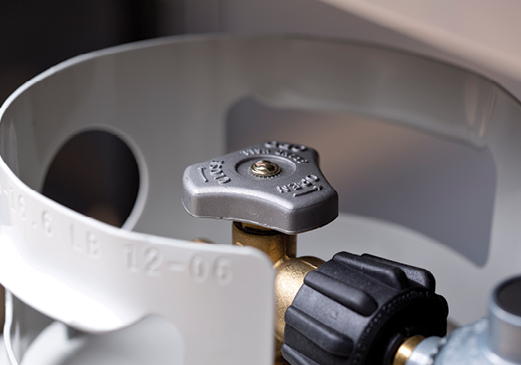How to Tell if Your Propane Tank Needs to be Recertified
Propane tanks are designed to safely withstand years of use, in both good and bad weather. In fact, it’s safest to store propane tanks outside rather than in a shed or a garage. But did you know that even the newest, sturdiest tank has a shelf life? Read on to learn when your propane tank should be inspected to be sure it’s in peak condition.
How Long do Propane Tanks Last?
How Many Times Can a Propane Tank be Recertified?
Specifications vary from country to country, but in the United States, a propane cylinder is qualified for 12 years from the date it was manufactured. After that, it needs to be requalified before it can be refilled. After that initial requalification, cylinders require requalification again every five years.
Do Propane Tanks Expire?
Propane tanks don’t “expire” per se. They simply need to be checked and requalified to be sure they still meet certain safety requirements. The easiest way to know if your tank needs to be requalified is to check the collar or handle on your propane tank. There, you’ll find a series of letters and numbers stamped into the metal. Using that information, you can determine how much time you have left before your tank needs to be requalified.

Decipher the “Code”
Now that you’ve located all those letters and numbers, what do they all mean? For starters, those markings contain important information about where your tank was made and its capacity rating. You should be able to find a date on the handle near the valve. That’s the manufacturing date. It’s usually written in a “Month-Year” format. So, if your tank was made in July of 2022, the numbers would read “07-22.”
Each tank is also stamped with a unique identification number. It’s sort of like the VIN on your car. That number sets your tank apart from every other tank out there, and it helps the U.S. Department of Transportation and propane dealers track tanks and keep their safety records up to date.
You’ll also notice some other markings, including a “TW” on the tank. That indicates the weight of the cylinder when empty. It can be helpful if you’re trying to determine how much propane is left in the tank. Another marking, “WC,” indicates the water capacity in pounds. This helps propane dealers figure out exactly how much propane can be safely stored inside.
You may also see a requalifier’s identification information stamped into the metal near the handle of your tank. If you can determine when the tank was made or recertified, you can also determine how much longer you’ll have before that tank needs to be requalified again.

Where Can I Find the Requalification or Recertification Date?
Here’s where things get a little trickier. Rather than being indicated by numbers, a grilling-sized propane tank’s recertification date is usually written out using a series of letters and numbers. You’ll find the month and year marked on the cylinder for both the manufacturing date and the requalification date. You’ll need to look for something like this:

The first seven numbers and letters are the tank’s identification, or RIN number. The next four digits indicate the year - in this case “0107,” meaning January of 2007. The letter “E” at the end indicates the tank was also visually inspected. This series of numbers and letters has the same meaning for larger Department of Transportation (DOT) specification propane tanks, too.
It's important to note that requalifications are extremely important to keep your tank running safely. However, if you notice any visible signs of wear and tear, such as dents, bulges, or cracks, or you notice that the valve isn’t working properly, you should take the tank to your nearest Ferrellgas location to get it professionally inspected, or exchange it at a retail store that sells Blue Rhino.
Where Can I Get My Propane Tank Recertified?
So, your tank isn’t as young as it used to be and needs to be requalified. Don’t worry, your next steps are pretty simple. First, you can exchange your grilling-sized tank for a fresh one at a local Blue Rhino retailer once it’s empty. Blue Rhino handles the requalification of tanks as part of its cylinder exchange process. Or you can find a qualified service location to inspect and requalify your tank. Ferrellgas has many of these locations across the country.
Safe Practices for Propane Tank Requalification
Bottom line, making sure your propane tank is up to date on its requalification is a matter of safety. You can rest easy knowing that every Blue Rhino tank you’ll find at the store has been cleaned, inspected, and leak tested so it’s ready to go when you’re ready to grill. If you have any unwanted propane tanks lying around, you can drop them off at any Ferrellgas location or leave them next to the outdoor Blue Rhino display at a store near you. Our goal is to keep our customers safe, happy, and grilling all year long. So don’t worry about it. You get the burgers, and we’ll take care of the rest.
CATEGORIES
Archives
- Summer 2025
- Spring 2025
- Winter 2024
- Fall 2024
- Summer 2024
- Spring 2024
- Winter 2023
- Fall 2023
- Summer 2023
- Spring 2023
- Winter 2022
- Fall 2022
- Summer 2022
- Spring 2022
- Winter 2021
- Fall 2021
- Summer 2021
- Spring 2021
- Winter 2020
- Fall 2020
- Summer 2020
- Spring 2020
- Winter 2019
- Fall 2019
- Summer 2019
- Spring 2019
- Winter 2018
- Fall 2018
- Summer 2018
- Spring 2018
- Winter 2017
